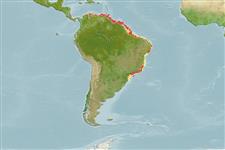Teleostei (teleosts) >
Clupeiformes (Herrings) >
Pristigasteridae (Pristigasterids)
Etymology: Pellona: Derived from Latin, pellis = skin (Ref. 45335).
Eponymy: Dr David Elson Harrower (1890–1970) was a member of the Philadelphia Academy of Natural Science, with interests in both anthropology and zoology. [...] (Ref. 128868), visit book page.
More on author: Fowler.
Environment: milieu / climate zone / depth range / distribution range
Ecology
Marine; brackish; pelagic-neritic; depth range 5 - 36 m. Tropical; 12°N - 30°S, 89°W - 32°W (Ref. 188)
Western Atlantic: Panama, Trinidad, and the Guianas southward to southern Brazil.
Size / Weight / Age
Maturity: Lm ? range ? - ? cm
Max length : 18.0 cm TL male/unsexed; (Ref. 5217); common length : 12.0 cm TL male/unsexed; (Ref. 5217); max. published weight: 33.00 g (Ref. 118626)
Dorsal spines (total): 0; Dorsal soft rays (total): 0; Anal spines: 0; Anal soft rays: 36 - 42. Belly with 17 to 20 + 5 to 7, total 22 to 26 scutes. Eye large, lower jaw projecting; upper jaw with a toothed hypo-maxillary bone between hind tip of pre-maxilla and lower bulge of maxilla blade. Pelvic fins with distinct axillary scale; anal fin long, its origin under middle of dorsal fin base. Scales easily lost (Ref. 188). Bluish gray above, sides silvery (Ref. 37032).
Found inshore, along beaches and down to at least 16 m over a muddy bottom. Enters estuaries, but perhaps not tolerating very low salinities (Ref. 12225).
Life cycle and mating behavior
Maturity | Reproduction | Spawning | Eggs | Fecundity | Larvae
Whitehead, P.J.P., 1985. FAO Species Catalogue. Vol. 7. Clupeoid fishes of the world (suborder Clupeoidei). An annotated and illustrated catalogue of the herrings, sardines, pilchards, sprats, shads, anchovies and wolf-herrings. FAO Fish. Synop. 125(7/1):1-303. Rome: FAO. (Ref. 188)
IUCN Red List Status (Ref. 130435: Version 2024-1)
Threat to humans
Harmless
Human uses
Fisheries: subsistence fisheries
Tools
Special reports
Download XML
Internet sources
Estimates based on models
Preferred temperature (Ref.
123201): 24.8 - 27.9, mean 27.3 °C (based on 82 cells).
Phylogenetic diversity index (Ref.
82804): PD
50 = 0.5156 [Uniqueness, from 0.5 = low to 2.0 = high].
Bayesian length-weight: a=0.00794 (0.00663 - 0.00952), b=3.02 (2.97 - 3.07), in cm total length, based on LWR estimates for this species (Ref.
93245).
Trophic level (Ref.
69278): 4.2 ±0.73 se; based on food items.
Resilience (Ref.
120179): High, minimum population doubling time less than 15 months (Preliminary K or Fecundity.).
Fishing Vulnerability (Ref.
59153): Low vulnerability (10 of 100).
Nutrients (Ref.
124155): Calcium = 227 [115, 485] mg/100g; Iron = 1.88 [1.11, 3.12] mg/100g; Protein = 19.5 [18.0, 20.8] %; Omega3 = 0.456 [0.222, 0.877] g/100g; Selenium = 33.1 [16.2, 68.4] μg/100g; VitaminA = 38.6 [14.0, 101.2] μg/100g; Zinc = 1.55 [1.05, 2.21] mg/100g (wet weight);
